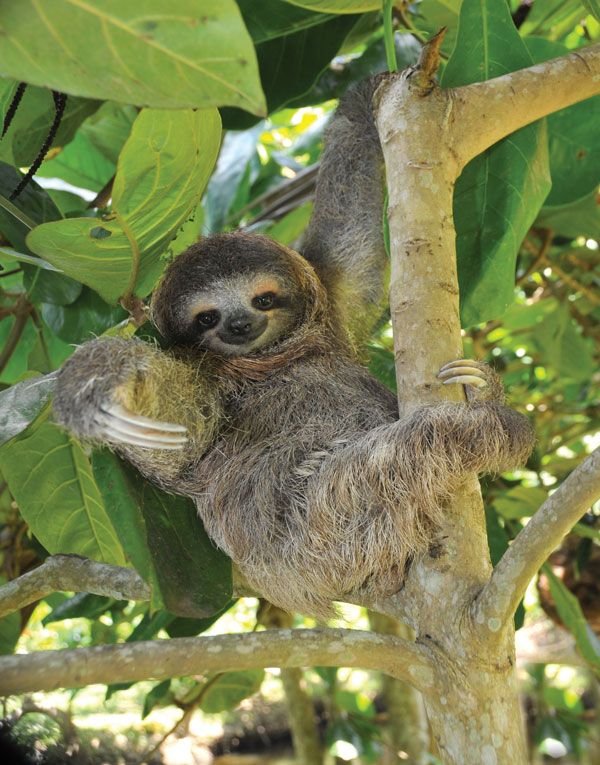
Picture this: deep in the lush canopies of Central and South America, three-toed sloths are hanging out in trees, blissfully munching on leaves. But lurking below are all sorts of dangers, from hungry jaguars to changing weather patterns. So, how do they manage? Let’s dig deeper into their world and explore the unique adaptations that enable them to thrive where many would struggle.
1. The Art of Slow Living
Three-toed sloths are masters of the slow lane. Their entire existence revolves around one main tactic: taking life easy. This slow lifestyle isn’t just a quirky personality trait; it’s an essential adaptation for survival. By moving slowly, sloths conserve energy, which is crucial because their diet primarily consists of low-energy foods like leaves.
Being sluggish helps them remain hidden from predators as well. Here’s the thing: many predators rely on movement to spot their next meal. By blending in with the trees and staying still for long periods, sloths become nearly invisible. It’s as if they’ve figured out the perfect recipe for camouflage and energy conservation.
Additionally, their slow metabolism means they can go for days without eating. This is particularly handy when food is scarce or the weather isn’t cooperating. So, in a way, their laziness is a clever survival strategy that allows them to endure harsh conditions most animals couldn’t handle.
2. Diet: Mastering Leaf Consumption
You might be wondering what three-toed sloths munch on to fuel their lives. Their diet mainly consists of leaves, fruits, and flowers. But before you think that sounds easy, let me explain: leaves are tough to digest, offering little energy. Sloths have evolved specialized stomachs, with multiple compartments that help break down these fibrous foods.
In fact, it can take a sloth over a month to fully digest a single meal! This slow digestive process allows them to extract the maximum amount of nutrients from their meals. Picture a slow cooker working its magic over an extended period—patience is the name of the game.
Moreover, sloths have a unique relationship with the bacteria in their gut. These helpful microorganisms play a crucial role in breaking down tough plant material, making nutrients available. This partnership helps sloths thrive even in areas where food can be sparse or less nutritious.
3. Coping with Climate Challenges
Living in the jungles of Central and South America, three-toed sloths face a variety of climate challenges, including heavy rains, humidity, and heat. You might think their thick fur would make them a sweaty mess, but it’s actually designed to help them stay cool! Their fur is not just a fashion statement; it has a unique structure that allows air to circulate, helping regulate their body temperature.
Additionally, sloths have a knack for staying hydrated. Their diet largely consists of leaves that contain a significant amount of water. When the rains come, they can often drink directly from the raindrops that gather on their fur. It’s a fascinating tactic that ensures they rarely go thirsty, even in the steaming heat.
Of course, during harsh weather events like tropical storms, sloths are at risk. Their slow movement may hinder their escape from danger, but they have a clever trick: they hang onto branches with their strong claws, sometimes as storms rage around them. By staying anchored to their tree, they ride out the worst of the weather.
4. Defense Mechanisms: Staying Safe from Predators
Despite their slow pace, three-toed sloths have developed some interesting defense mechanisms. Their greatest allies are their camouflaged fur and low energy lifestyle. The green algae that often grows on their fur provides excellent camouflage, making it difficult for predators like hawks and jaguars to spot them.
But that’s not all. Sloths are surprisingly tough when it comes to defending themselves. If threatened, they can deliver a serious bite. Their long claws, while useful for climbing, can also be intimidating. Predators usually think twice before going after a sloth that could potentially swipe at them.
Interestingly, sloths can also rely on their low metabolic rate to avoid being seen. Because they move so little, they can go unnoticed by predators lurking nearby. Imagine hiding in plain sight, just hoping that no one notices you’re there. This unique combination of traits allows them to thrive, even with natural enemies around.
5. Unique Adaptations for Survival
Three-toed sloths are not just masters of slow living; they also possess unique adaptations that help them navigate their environment. For starters, their long arms are perfect for reaching out to grab leaves and branches. This makes foraging for food relatively easy, even if they have to use a lot of energy in the process.
Another fascinating aspect is their strong grip. Those long claws are specially designed to help sloths hang onto branches, making it nearly impossible for them to fall. This isn’t just convenient for tree-dwelling life; it’s vital for safety. Imagine climbing a tree and never having to worry about slipping—pure sloth magic!
Finally, their eyes are positioned on the sides of their heads, giving them a wider field of vision. This helps them spot movement in the trees around them, which is crucial for staying safe from predators. It’s like having a built-in security system while hanging out in the lush canopy.
6. The Importance of Their Ecosystem
Sloths might seem like they’re just hanging around all day, but they play a crucial role in their ecosystem. By munching on leaves and fruits, they help promote plant health and growth. Their slow metabolism means that they often act as fertilizing agents. As they digest their food, they often release nutrients back into the soil through their waste.
Additionally, sloths provide food for various predators, helping maintain the balance in their ecosystem. Even the algae that grow on their fur contributes to the habitat. This unique relationship underscores how interconnected all creatures are in their environments.
By understanding the role of three-toed sloths in their habitats, we can appreciate their survival tactics even more. They’re not just surviving; they’re helping sustain the ecology around them.
7. Conservation: Protecting the Sloth’s Habitat
As adorable as three-toed sloths are, they face significant challenges due to habitat loss and climate change. Deforestation is a serious threat, as their homes are cut down to make way for agriculture and urban development. Without their tree canopies, sloths struggle to survive, making conservation efforts essential.
Organizations around the world are working to protect these unique creatures and their habitats. By preserving forests and promoting sustainable practices, we can help ensure that sloths continue to thrive in their natural environments.
It’s essential for us to understand the impact of our actions. By supporting conservation initiatives, we can play a part in protecting not only sloths but also the entire ecosystem they belong to.
In conclusion, three-toed sloths may seem like laid-back junglers, but their incredible adaptations for survival in harsh environments reveal a world of cleverness and resilience. From their slow pace and unique diets to their defense mechanisms and ecological roles, sloths are a testament to the beauty and complexity of nature. As we learn more about them, we gain a greater appreciation for their place in our world—and the importance of protecting it.

